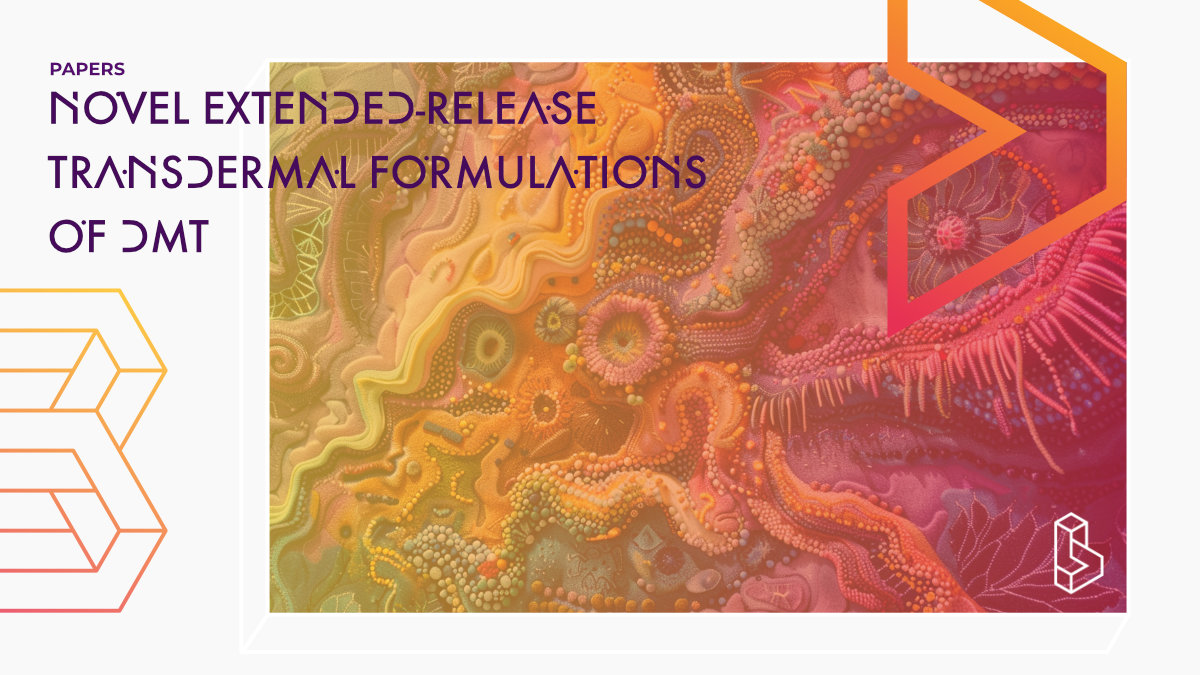This paper outlines the formulation development, in vitro, and in vivo testing of transdermal drug-in-adhesive DMT patches using various adhesives and permeation enhancers. In vivo behavioural and pharmacokinetic studies performed with lead patch formulation (F5) in male and female Swiss Webster mice showed that transdermal administration provided consistent, extended drug release at a non-hallucinogenic dose, with a 77% bioavailability compared to IV at two dosages.
Abstract of Novel extended-release transdermal formulations of the psychedelic N,N-dimethyltryptamine (DMT)
“There is considerable evidence from the literature that psychedelics, such as N,N-dimethyltryptamine (DMT), are safe and effective treatments for depression. However, clinical administration to induce psychedelic effects and expensive psychotherapy-assisted treatments likely limit accessibility to the average patient. There is emerging evidence that DMT promotes positive behavioral changes in vivo at sub-hallucinogenic dosages, and depending on the target indication, subjecting patients to high, bolus dosages may not be necessary. Due to rapid metabolic degradation, achieving target levels of DMT in subjects is difficult, requiring IV administration, which poses risks to patients during the intense hallucinogenic and subjective drug effects. The chemical and physical properties of DMT make it an excellent candidate for non-invasive, transdermal delivery platforms. This paper outlines the formulation development, in vitro, and in vivo testing of transdermal drug-in-adhesive DMT patches using various adhesives and permeation enhancers. In vivo behavioral and pharmacokinetic studies were performed with lead patch formulation (F5) in male and female Swiss Webster mice, and resulting DMT levels in plasma and brain samples were quantified using LC/MS/MS. Notable differences were seen in female versus male mice during IV administration; however, transdermal administration provided consistent, extended drug release at a non-hallucinogenic dose. The IV half-life of DMT was extended by 20-fold with administration of the transdermal delivery system at sub-hallucinogenic plasma concentrations not exceeding 60 ng/mL. Results of a translational head twitch assay (a surrogate for hallucinogenic effects in non-human organisms) were consistent with absence of hallucinations at low plasma levels achieved with our TDDS. Despite the reported low bioavailability of DMT, the non-invasive transdermal DMT patch F5 afforded an impressive 77 % bioavailability compared to IV at two dosages. This unique transdermal delivery option has the potential to provide an out-patient treatment option for ailments not requiring higher, bolus doses and is especially intriguing for therapeutic indications requiring non-hallucinogenic alternatives.”
Authors: Christopher G. Witowski, Mika R. Hess, Nate T. Jones, Molly C. Pellitteri Hahn, John Razidlo, Riya Bhavsar, Christina Beer, Natalie Gonzalez-Velazquez, Cameron O. Scarlett, Cody J. Wenthur & Jacqueline L. von Salm
Summary of Novel extended-release transdermal formulations of the psychedelic N,N-dimethyltryptamine (DMT)
Psychedelic compounds, largely overlooked by industrialized nations since the 1960s, have emerged again as promising drug classes for psychiatric and addiction disorders. However, the methods of drug delivery to patients have not been optimized for non-oral active psychedelic drugs or those with low bioavailability. DMT is ubiquitously produced throughout nature and is hypothesized to be the endogenous ligand to 5-HT2A. Despite these intriguing developments, DMT remains a Schedule 1 drug in the United States.
DMT is currently being tested in several clinical trials for stroke, traumatic brain injury and major depressive disorder. It is presumed that drug-induced neuroplasticity, increasing dendritic spines and formation of new neural pathways contribute to the therapeutic effects of these drugs. The head-twitch response assay (HTR) has been used as a predictive pre-clinical method to define hallucinogenic and sub-hallucinogenic doses of DMT, which have been shown to produce similar synaptic signatures in rat brains to that of a larger, psychedelic dose. A functional study showed that DMT affects multiple cellular pathways, and that 5-HT2AR antagonism still achieved DMT-induced neuroplasticity. Therefore, non-invasive low-dose DMT dosage forms could offer a new paradigm to achieve therapeutic effects. Transdermal drug delivery systems of psychedelics have only been postulated, but there is positive application in psychiatry with Emsam (selegiline) and Secuado (asenapine) as well as Adlarity (donepezil) for Alzheimer’s disease. DMT is an attractive candidate for transdermal delivery, but its short half-life makes it challenging to drug.
This study outlines the design and development of single layer drugin-adhesive patches containing DMT freebase. The patch formulation was optimized using Franz cell diffusion and tested in both male and female mice for pharmacokinetics and hallucinogenic potential.
Find this paper
Novel extended-release transdermal formulations of the psychedelic N,N-dimethyltryptamine (DMT)
https://doi.org/10.1016/j.ejps.2024.106803
Open Access | Google Scholar | Backup | 🕊
Cite this paper (APA)
Witowski, C. G., Hess, M. R., Jones, N. T., Hahn, M. C. P., Razidlo, J., Bhavsar, R., ... & von Salm, J. L. (2024). Novel extended-release transdermal formulations of the psychedelic N, N-dimethyltryptamine (DMT). European Journal of Pharmaceutical Sciences, 199, 106803.
Study details
Compounds studied
DMT

